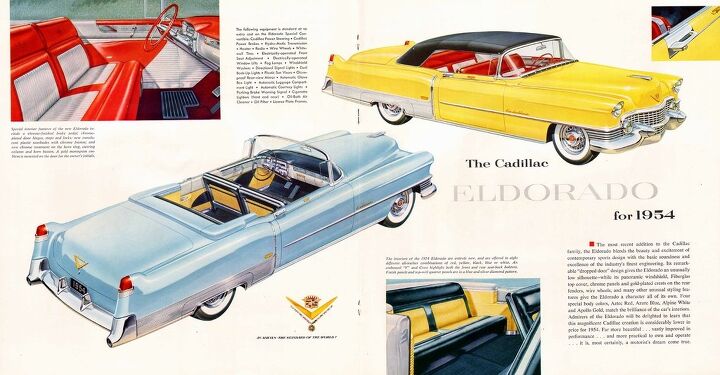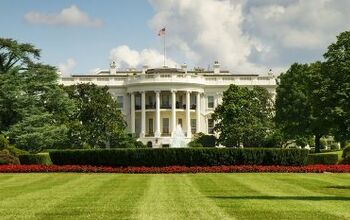Rare Rides Icons: The Cadillac Eldorado, Distinctly Luxurious (Part VI)

As we learned in our last installment, when the second generation Eldorado debuted in 1954 it was repositioned at Cadillac. No longer was it an ultra expensive and largely hand-built conveyance for a select few who could afford it. Rather it appeared as a sort of premium trim package on top of the company’s bread and butter Series 62. No unique body panels, no special interior design, no single-model windshield. Was there much left to differentiate Eldorado from its sibling?
Though Cadillac’s lineup wore sleeker bodywork in 1954 and all models were new, they continued on the same platforms used in 1953. That meant the Series 62, Eldorado, and Sixty Special all used the same C-body chassis. Stretched for 1954, all examples of the Series 62 had a 129-inch wheelbase, compared to 126 inches the previous year. As before, Eldorado matched its wheelbase to the Series 62.
In their debut year, new third-gen Series 62 models were 223.4 inches long in two-door guise, or 216.4 inches as a four-door. The longer, lower trend was evident immediately as the sleek new Series 62 cars gained almost three inches in length with two doors, and just under an inch as four-doors. Overall height dropped from 62.7 inches in 1953 to 62.0 in 1954, and though the Eldorado of 1953 was notably lower in overall height than its more common sibling, that distinction did not carry through to 1954. The only area where the 1954 Series 62 and Eldorado shrunk was width: An 80.1-inch width of 1953 was reduced to 79.6 inches in 1954.
The extra length and trim changes meant roughly 100 pounds of extra weight across the board. Series 62 models weighed between 4,500 to 5,100 pounds depending upon body style and trim. The Eldorado of 1953 weighed an even 5,000 pounds in any guise given its very limited options, but in 1954 its heft ranged between 4,900 and 5,100 pounds.
The Monobloc 346 cubic inch (5.7L) V8 bowed out after 1953, which left the Series 62 and Eldorado powered only by the 331 OHV V8 from 1954 to 1955. In 1956 a new OHV (overhead valve) V8 debuted that was larger and more powerful than the 331. The 365 cubic inch (6.0L) engine directly replaced the 331 in the Series 62 and Eldorado of 1956.
The 331 was the first Cadillac OHV developed, and debuted in 1949 across the Cadillac lineup. Rated at 210 gross horsepower (160 net), the 331 continued unchanged through its final usage. But change to a new engine was needed: With quite a bit of heft to move and a four-speed automatic, Popular Mechanics found the 1954 Series 62 and Eldorado managed 60 miles per hour in 17.3 seconds. How luxurious!
The 365 was created by increasing the 331’s bore to 4 inches, while keeping the stroke the same 35⁄8”. 1956 Series 62s equipped with the 365 could be fitted with a single 4-barrel carburetor, which meant the engine produced 285 gross horsepower. The Eldorado had dual 4-barrel carbs as standard, which meant a more impressive 305 horsepower figure.
Worth noting, the dual-carb version of the 365 was available in Series 62 and other Cadillac models. The 365 improved acceleration drastically, and when the Series 62 was tested again in 1956 the 0-60 time dropped to a much more respectable 12 seconds flat. In exchange for those 285 horsepower the engine managed 8.3 miles per gallon.
Carried over from the prior generation Series 62 and Eldorado was the four-speed Hydra-Matic automatic transmission. Previously an option on Series 62 but standard on Eldorado, in 1954 it became the only transmission choice available. American transmission tastes were already changing, and a three-speed manual in a luxury car of the Fifties did not have a high take rate.
The 1954 Series 62 and Eldorado were an early example of power equipment and technology becoming expected as standard on luxury cars. While in 1953 the heater was optional even on Cadillac models (except Eldorado), things began to change circa 1954. Series 62 gained new whiz-bang features like automatic windshield washers, a 12-volt electrical system, and power steering. Drivers were reminded their parking brake was on via a new light on the dash.
Features still separated as optional extras were power windows, power steering, seats, and automatic headlamp dimming. Still reserved for the wealthy was that most expensive luxury option, air conditioning. GM purchased a Frigidaire system that was self-contained for use in Cadillacs. The system was fitted by the dealer upon customer request.
In addition to developments in the appearance of Series 62 and Eldorado each model year, there were new features added as standard. For 1955 tubeless tires became a standard feature. And safety was enhanced generally via new reversing lamps and turn signals fitted as standard equipment. In 1956 power steering moved from optional to standard.
The annual visual changes and additions to the standard equipment helped to push Cadillac’s sales to new heights, particularly for the Series 62 model range. In particular to the Eldorado, at the end of its run an exciting new hardtop version debuted: the Eldorado Seville. While the Seville name turned out to be very long-lived, so did a new top trim of the convertible called Eldorado Biarritz.
In our next installment we’ll review the initial exterior styling of the Eldorado that appeared in 1954. We’ll check it out in context to the unique styling of the 1953 Eldorado, and highlight the differences between Eldorado and the very similar Series 62 convertible.
[Images: GM]
Become a TTAC insider. Get the latest news, features, TTAC takes, and everything else that gets to the truth about cars first by subscribing to our newsletter.

Interested in lots of cars and their various historical contexts. Started writing articles for TTAC in late 2016, when my first posts were QOTDs. From there I started a few new series like Rare Rides, Buy/Drive/Burn, Abandoned History, and most recently Rare Rides Icons. Operating from a home base in Cincinnati, Ohio, a relative auto journalist dead zone. Many of my articles are prompted by something I'll see on social media that sparks my interest and causes me to research. Finding articles and information from the early days of the internet and beyond that covers the little details lost to time: trim packages, color and wheel choices, interior fabrics. Beyond those, I'm fascinated by automotive industry experiments, both failures and successes. Lately I've taken an interest in AI, and generating "what if" type images for car models long dead. Reincarnating a modern Toyota Paseo, Lincoln Mark IX, or Isuzu Trooper through a text prompt is fun. Fun to post them on Twitter too, and watch people overreact. To that end, the social media I use most is Twitter, @CoreyLewis86. I also contribute pieces for Forbes Wheels and Forbes Home.
More by Corey Lewis
Latest Car Reviews
Read moreLatest Product Reviews
Read moreRecent Comments
- 28-Cars-Later Let's review Ol' Joe's earlier thoughts on the matterTrump doesn’t get the basics. He thinks his tariffs are being paid by China. Any freshman econ student could tell you that the American people are paying his tariffs.The cashiers at Target see what’s going on – they know more about economics than Trump. #TeamJoe 1:59 PM · Jun 11, 2019I think the cashiers may also know more about managing the presidency too Joe. What is it you do again?
- 28-Cars-Later So the company whose BEVs are without proven lifespan and mired in recalls wants to further cheapen materials and mfg costs of the very same thing they already cannot sell? I don't know if Ford is going to still exist in 2030 (assuming the nation still does of course).
- Fred We want our manufacturing to pay good wages, provide healthcare, not pollute and provide a safe workplace. Many places around the world don't, so we put a tariff on them to force them. That's the way it should be, but I'm afraid this is just a political move by Biden to take away one of Trump's talking points.
- Orange260z Modern Cadillac sedans look and drive great. Yeah, the interior materials aren't quite as good as the competition, but if they undercut them in price it can offset. IMHO, they need to step up in a big way on their warranty, service and customer service. H/K/G shows confidence in the quality of the product by offering long standard B2B warranties and low-cost exclusionary extensions. My Caddy became a money pit after the warranty with only 75K kms; yes, the Germans do that, but they have the established cachet that they get away with it. They need to make sure that their cars still look good after 10 years (i.e. no trim issues, no undercarriage rust issues, etc) - my CTS was all rusty underneath after two years, they told me that was acceptable and not under warranty. Cadillac needs to do more.In Canada, there are few (if any) standalone Cadillac dealerships; they are typically co-located with all the other (remaining) GM brands. However, this doesn't have to be a kiss of death - Lexus successfully built their rep despite co-location, by investing in dedicated Lexus sales areas, sales people, service advisors, technicians, lounge areas with private offices, perks (free coffee/treats, car wash and vacuum with any service, a large complimentary Lexus loaner fleet available for any service visit), etc. By contrast, for Cadillac service I would line up with the 20 other people waiting for one of 5-7 service writers that know nothing about my car because they service 10,000 different GM models, answering a question about maintenance requirements "How am I supposed to know?". During the first 4 years I had access to complimentary Enterprise rental cars as loaners, but I had to spend 20-30 mins going through a car rental process every time. The guy who would do complimentary service washes did so with a big scrub brush he just used to wash a work truck that was covered in mud. They can't sell a premium car with crappy service like that, they have to be better than their competition.If it weren't for these issues I would not have hesitated to buy a new CT5 V-sport (winter DD, want AWD). I bought a G70 instead, we'll see how that goes - but at least I have a long B2B warranty.
- Jalop1991 Are tariffs the right answer? Ask China and Japan. They've imposed lots of protectionist tariffs over the years, but somehow our doing so is horrible or something like that.Let's do the Japanese inspection to the Chinese junk imports, and make the Chinese pay for them.BYD--now available at Walmart and Amazon.







































Comments
Join the conversation
Corey: Typo perhaps - "The only area where the 1954 Series 62 and Eldorado shrunk was width: An 80.1-inch height of 1953 was reduced to 79.6 inches in 1954."
"And safety was enhanced generally via new reversing lamps and turn signals fitted as standard equipment."
Did not get it, turn signals were optional in 1954?